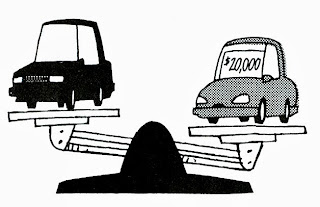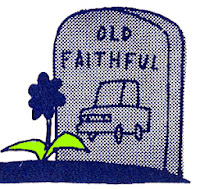These are times of tough choices for most Americans. Among the higher living expenses we face are rising cost of car ownership: original cost, taxes, insurance, maintenance and depreciation. Many of us will face the decision of whether to fix up or replace our present vehicle. Some of the facts and figures in this blog may help owners make a wise decision.
When an aging car needs repairs, too often the solution lies in the quickest route to the dealer’s showroom. But supposing the amount of the down payment (plus a little extra) were spent on the old car instead, making it serviceable for at least another year?
What is it, exactly, that bothers you about the car you own? Does it need brake or transmission work, upholstery repairs or a paint job? Most of us find it is easier to go out and purchase a new or newer vehicle than to repair the one we already own.
Yet, one thing is certain: no matter what major work your car, truck or van needs, it probably won’t cost as much as buying a new one.
Consider your options. You own, or nearly own, your car. It’s been a faithful member of the family, but at an average age of eight years, it needs repairs. Although you’ve saved enough for a down payment on a new one, even with your trade-in the balance is likely to be large. The monthly payments are hefty and, seemingly, eternal.
Some Frequently Asked Questions About Replacement Parts
“Lets say my engine or transmission is shot. Or i need a new starter or alternator. Can i get them overhauled?”
You have several options. Overhaul is one. Or, if money is tight you may be able to replace it with a used unit from a salvage yard. this generally is risky and there is little warranty. In some cases if you go with the used option at one of our Motorcars Service Facilities you can purchase additional warranty that includes labor (ask you Motorcars Service Manger for details).
You can have your engine or transmission overhauled or you can have a rebuilt(or re-manufactured) component installed.
“What’s the difference between overhauling and rebuilding?”
Overhauling procedures vary widely. Your engine may or may not be disassembled down to the block with all new parts installed.
A quality re-manufactured or rebuilt component will be dissembled, and everything subject to wear will be replaced.
Although the price tag may be half that of a new part, a re-manufactured part will look and perform virtually the same as new and will comply with original equipment standards.
“Why not install factory new parts?”
The main reason is price. Original equipment parts, available from the car dealer, are more expensive and may carry no better warranty than aftermarket or re-manufactured parts available from alternate sources.
Warranties do vary widely and should be investigated before selecting a replacement part. Remember, too, that a warranty seldom covers labor, which can cost more then the part.
About Financing
If paying cash for repairs seems more difficult than monthly payments for a new car, talk to your banker or credit union. Financial institutions always are eager to make new car loans. But how do they greet a customer planning to renew rather than replace his or her vehicle?
Most banks are happy to finance a loan to repair a car. Although the interest rate may be higher than a conventional car loan, they consider this a positive situation for everyone concerned. Here’s how a banker may see it:
- The amount of the loan usually is small and, therefore, a reduced risk;
- The payments are affordable for the customer who will be developing a healthy credit rating;
- The customer is less likely to get in over his or her head;
- The loan usually is short term;
- The customer has time to save for a larger down payment when he or she does decide to buy another vehicle.
How to Know When you’ve Reached the Point of Diminishing Return
Despite the often high cost of replacing a vehicle, fixing up the old one is not always the wisest choice. Following are some things to consider. If combined repairs on an older car far exceed its value, it’s generally better to trade up. Factors that can affect your decision:
- Neglecting maintenance too long could lead to an accumulation of needed major mechanical work, such as overhaul of an engine and/or transmission plus braking system. Overhauling either the engine or transmission on a typical full size car could cost $3000 – $8000, possibly far exceeding the value of the car
- Once mechanical systems are restored will you be faced with big expenses for body and/or interior fix-up?
- Would your repaired expenses be better invested in a new or newer vehicle? The age and model of your car must figure into the equation. A used car appraiser’s guide may show the “blue book” value to be so low, even in restored condition, that this investment wouldn’t make sense.
- How important are the state-of-the-art safety and fuel economy features of a new or newer vehicle? How important is the “image” created by the vehicle parked in your driveway?
- Would “Old Faithful”, even fully restored, suit your present needs as well as a different vehicle might? Larger family, different business requirements, new recreational interest and other life-style factors change one’s transportation needs.
Survey Report: Who Buys Re-manufactured Engines
Contrary to popular belief, lower income owners are not the driving force behind services that extend car life. Instead, according to a survey of 352 motorists, 52% of people who had re-manufactured engines installed were professionals or executives. 42% claimed annual salaries in excess of $40,000. There were more women customers than men.
The survey, conducted by a large franchiser of engine installation centers, shows 58.8% of respondents made the decision to install re-manufactured engines because they believe it was more cost effective than investing in a new car.
Decisions, Decisions…
A few points in favor of renewing vs replacing:
- Less sales tax to pay;
- No big car payments and, therefore, an opportunity to save for a future new car purchase;
- You’ll probably save on insurance premiums;
- For better or for worse, you do have a “known quantity” in the car you own;
- That new car could lose 25% of its value once it drives out of the showroom; 40% of its value in four years;
- Your old car will be in better shape for future trade, to sell or to pass on to family or friends.
Combating New Car Fever
When new car fever strikes you can strike back by writing down the pros and cons to what often is an emotional decision.
In general it’s good to remember that your old car probably can outlast the urge for a new one. If you’re willing to spend a little extra money on fixing up and dressing up Old Faithful, you’re likely to be way ahead.
Dressing It Up
One way to curb the urge to turn in that good old car is to dress it up, inside and out. Perhaps a paint job with a little pinstriping, cleaning and repairing interior fabrics, maybe even installing a sun roof, can make ” Old Faithful” look almost like new.









